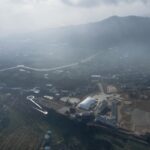The YingYao Sandware Museum Complex, designed by a9architects, is a testament to the rich cultural heritage of Yingjing County in Ya’an City, China. Rooted in a legacy of black sandware art spanning over two millennia, this project seeks to create a vibrant cultural tourism destination while preserving the region’s intangible cultural heritage.
Concept and Design
The architectural design of the Sand Museum draws inspiration from Yingjing’s cultural and ecological context, incorporating elements that pay homage to the region’s ancient traditions. Emphasizing the solidity and depth of sandware, the buildings feature robust facade designs, creating a striking visual dialogue with the surrounding landscape.

Integration with Landscape
Utilizing local stone and pebbles, the plaza serves as a communal space for exploring sandware culture and craftsmanship. The seamless transition between indoor and outdoor spaces, coupled with the natural waterscape, fosters a harmonious relationship between the built environment and the earth.
Visual Composition
Employing framed scene composition techniques, the design expands the visual space to encompass distant landscapes, evoking the imagery of an unfolding scroll painting. Large windows and grid structures further enhance the connection to the natural surroundings, creating a sense of immersion amidst mountains and rivers.

Revitalizing Tradition
A9architects pay homage to tradition while infusing the design with contemporary vitality. Local materials, such as coal ash, are repurposed to adorn the exterior walls, symbolizing a renewed connection to the site’s cultural roots. The project aims to reintegrate sandware into daily life, promoting cultural continuity and harmony between nature and human-made elements.
Conclusion
The YingYao Sandware Museum Complex represents a harmonious blend of tradition and innovation, showcasing the enduring legacy of black sandware art in Yingjing County. By embracing the region’s cultural heritage and natural beauty, the project not only celebrates the past but also paves the way for sustainable cultural tourism development in the future.
















